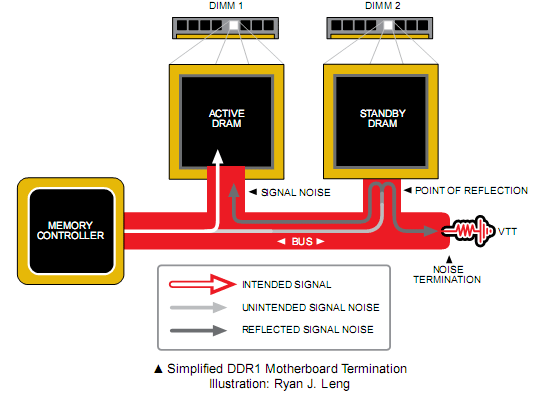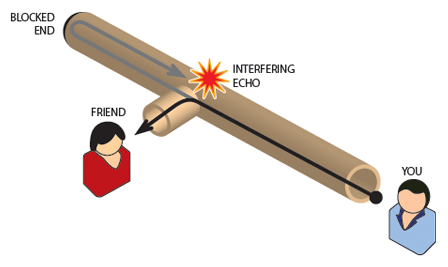
Data Prefetch
DDR1 uses a “2n-prefetch” design, which means at each cycle, the memory module prepares 2-bits worth of data from the memory banks in 1 clock cycle, then lines them up back-to-back in the IO buffers before sending them out on the data line. This design is fairly simple yet elegant: for each pair, one bit of data is sent along the rise and one along the fall of the signal wave, effectively doubling the data throughput without increasing the DRAM core frequency.
Reflected Noise Management
In order to improve signal quality, resistive termination was built into the motherboard’s memory IO operation to cut-off a type of noise caused by signal echoes. The noise is caused by signals being reflected from ends along the data bus, reflecting back to interfere with the new signals. The clash between new signals and the echo of old signals induces jitters and destructive interference. Signals can be reflected at points where impedance differs, such as at bus and DRAM connection points.
It is important to note that this method only manages the noise level within the parameters that DDR1 was designed to perform between. Outside of this it does not remove them completely, or even adequately causing stability problems.
An Analogy: The Reflected Problem
Reflected signal noise is similar to sound travelling down a long pipe and subsequently being reflected back from a closed end, where you will hear it as an echo. Now imagine, halfway along that long pipe, there is an opening where your friend is listening. When you talk to your friend down the pipe, the sound travels to them halfway and continues to the very end of the pipe, only to bounce back as an echo.
When your friend starts to reply, the echo will interfere with their message. Hence, it makes listening to the reply a bit difficult. As you two talk faster and faster, it becomes harder and harder to follow the conversation; this is similar to speeding up memory frequency while dealing with signal reflection.
One solution is muffling the end of the pipe so the noise is absorbed – on-board resistive termination acts like this by sucking unintended signals away before they are reflected back.

MSI MPG Velox 100R Chassis Review
October 14 2021 | 15:04








Want to comment? Please log in.